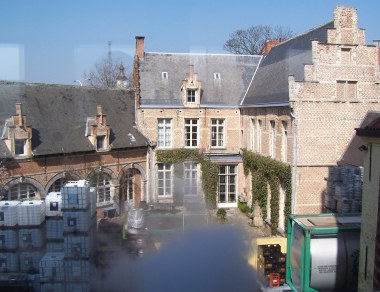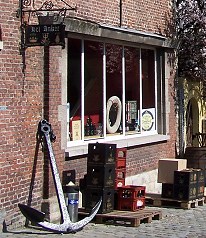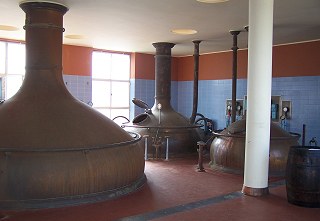 |
 |
|

|
|

|
 |
home
about
Protz
features
A-Z
books
|
|
Protz:
features
reviews
tastings
news & events
books
|

| |
Het Anker in the spotlight
by Willard Clarke, 06/09
Nuns, emperors, dukes and beer forge a rich heritage at Het Anker Brewery in Mechelen. It was the fortuitously named Duke Charles the Stout who decreed in 1471 that nuns in the Low Countries could brew beer for their hospices free from tax.
As a result, sisters from a convent in Mechelen, then the capital of this northern outpost of the Holy Roman Empire, moved to a new site in the city in 1596 where they built their
Hospice de Beaune. The buildings included a small brewery where beer was made to comfort the sick and the dying. (right, the old convent viewed from the brewery).
The nuns left the hospice in 1865 and seven years later the site was sold to Louis van Breedam who expanded the brewing operation and called his company Het Anker.
|
|

|
The name both commemorated the name of Jan In Den Anker, a maltster who opened Mechelen's first brewery in 1369, and also maintained the religious theme, reminding pious drinkers that hope is the anchor of the soul.
In 1930 the then owner of the brewery, Charles van Breedam, took the fateful decision to stop brewing Pils lager and went back to making warm-fermented ales. The rise of big breweries such as Stella Artois, with sophisticated modern equipment, made it impossible for a small company such as Het Anker to compete in the Pils market.

|
|
A major turning point in Het Anker's fortunes came in 1963 when another member of the ruling family, Michel van Breedam, launched a new strong beer called Gouden Carolus. The name, Golden Charles, came from a coin minted during the reign of one of the most famous Habsburg emperors, Charles V (1500-1558), who grew up in Mechelen.
Under his rule, the empire encompassed most of Europe but his awesome duties left him time to drink the beer of his home city. Years later he had supplies of Mechelen beer sent to him at a monastery in Spain, his retirement home.
He wanted the beer, he said, because "the daughter of the grain is superior to the blood of the grape". Truly such a man deserves to have a beer named after him.
|
The brewery is a fascinating blend of old and new. The offices - with a large anchor by the entrance - are based in part of the former convent, a group of mellow stone and gabled buildings. A cobbled yard leads to the brewery, which includes a now redundant maltings, the first building constructed of concrete in the city early in the 20th century.
From the brewhouse you can look down over the convent. I noticed a large trampoline on the grass, which conjured up an image of flying nuns.
"There are no nuns there now," Charles Leclef, the general manager, laughed. He lives there with his family. He is the fifth generation of the Breedams to run the company and is descended from the female line.
|
|

|
Charles is young, energetic, bouncing with enthusiasm - well, he does have a trampoline. He has stabilised the business and rebuilt its fortunes. When he took over in 1990 the brewery, by his admission, was "run down - it lacked investment." He went into partnership for three years with the Riva group, best known for Dentergems and Liefmans beers.
"That didn't work out so I then went into partnership with John Martins in 1997," he said. Martins is a major beer wholesaler in Belgium but once again the relationship wasn't beneficial and Het Anker was down to just 1,300 hectolitres a year.
Charles decided the only way forward was complete independence, with investment from outside sources. It has worked. Today Het Anker brews 14,500 hectos a year. If that seems like a miracle, you've come to the right place.

|
|
The brewery is an adroit mixture of ancient and modern. The vessels in the brewhouse - mash tun, mash filter and copper - date from 1947 - while one floor below modern conical fermenters were installed five years ago. To cope with demand, a further four fermenters are due to arrive soon. Fermentation lasts for five days. The beer is then filtered and left in conditioning tanks to ripen for a short period. Three-quarters of production is packaged, and yeast and sugar are added to encourage a strong second fermentation in bottle.
|
On a previous visit I was taken up to the roof of the brewery to see the remarkable "cool ship", a large open copper trough surmounted by a canopy. The hopped wort or sugary extract was cooled there prior to fermentation. Visiting the roof enabled visitors to get a spectacular view of Mechelen with its panoply of medieval buildings and churches.
In the 1990s the brewers denied that the cool ship left the wort open to attack by wild yeasts. But while the trough is still there, a fascinating example of an old brewing artefact, it's no longer used. Cooling now takes places in a conventional paraflow inside the brewery.
Het Anker is busily building on the success of Gouden Carolus. The original beer is now branded as Classic to distinguish it from Gouden Carolus Tripel, Ambrio and Hopsinjoor - the last named means "extra hop". The company has added to its portfolio Lucifer (8.5%), previously owned by Riva. This is similar in style to the celebrated golden ale, Duvel, produced by Moortgat.
Once a year, the brewery produces a strong (11%) version of Classic called Cuv�e van de Keizer - the Emperor's Vat. The beer is brewed on 24 February, the birthday of Charles V. He would be impressed but I wonder what he would make of the brewery's latest offering, a single malt whisky.
Charles Leclef denies that making whisky is a departure from tradition. On the contrary, he argues, he's restoring tradition.
"We've turned full circle," he says. In the 18th century the brewery made geneva or gin. It's a common practice in the German and Dutch speaking countries: several German brewers also produce schnapps.
Charles took a special batch of Gouden Carolus Tripel, brewed without hops, to a gin distiller, where it was turned into whisky and left to mature for three years.
|
|
|
He was sufficiently impressed with the result to take on Ali Bosmans, a marketing man with a passion for whisky, to produce Gouden Carolus Single Malt on a regular basis. He makes the whisky on site, using pot stills. It's matured in Jim Beam bourbon casks sold to Speyside distillers in Scotland. Two floors of the old maltings are used for making and storing the whisky.
Visitors to Het Anker can buy a Connoisseurs' Pack of whiskies, aged between one and three years. Ali Bosmans describes his single malt as "summer whisky" and it has a delightful aroma and palate of honey, banana and tropical fruit.
Back to the beer. Gouden Carolus is exported to 24 countries, with the United States leading the pack. Britain is well down the list, behind the likes of Mexico, France, Denmark, Italy and Japan. It needs greater appreciation here. It's a world classic and the British need better acquaintance with "the daughter of the grain".
the beers
Head brewer Hans Van Remoortere took me through a tasting of the Gouden Carolus range.
Classic 8.5%
Five malts are used: Pils, wheat, light and dark caramalt and roast. The hop is Goldings. It has a ruby colour and an enticing aroma of port wine, chocolate and spicy hops. Burnt fruit (raisins) builds in the mouth with chewy malt and continuing chocolate and spicy hops. The finish has enormous length, is bittersweet with fascinating hints of liquorice, roasted grain, dark fruit, chocolate and tangy hops.
Tripel 9%
Brewed with Pils malt and wheat malt and spiced with coriander, cura�ao and a secret herb. It's hopped with Goldings. The pale gold beer has a spicy and herbal nose with warming alcohol, juicy malt, tropical fruits and spices in the mouth. The finish is fruity, herbal and spicy, with a luscious sweet malt note and gentle hop bitterness.
Ambrio 8%
A grist of Pils, wheat, pale cara and roasted malts. Two hops, Challenger and Goldings, are added at different stages in the copper. The beer has a burnished gold colour and a roasted and toasted grain aroma backed by peppery hops. It's intensely fruity in the mouth, but the fruit is balanced by spicy hops. The finish starts bittersweet but becomes dry with sappy malt and peppery hop notes.
Hopsinjopor 8%
Brewed with Pils and wheat malts. The complex hop grist is made up of Goldings, Hallertau, Saaz and Spalt. It has a straw colour, spicy hops, tart lemon fruit and rich malt on the aroma and a tangy, hoppy palate with juicy malt and bitter hops. The finish is intensely bitter and hoppy but there is a fine balance of malt and citrus fruit.
Cuv�e van de Keizer 11%
A stronger version of Classic, is russet coloured with a big fluffy head, a spicy and herbal nose with dark, burnt fruit, freshly-cut wood and bitter chocolate. Chocolate, dark grain, vinous fruit, wood and peppery hops fill the mouth, with blackcurrant fruit, woody notes, chocolate and light hops in the finish.
Mechelen is 30 minutes by train from Brussels Midi station, the Eurostar terminus.
Tours are usually available but are temporarily suspended while extensions to the brewery are underway. The excellent restaurant and bar by the entrance to the brewery is also currently closed while refurbishment is carried
out.
|
|
home
about
Protz
features
A-Z
books
|